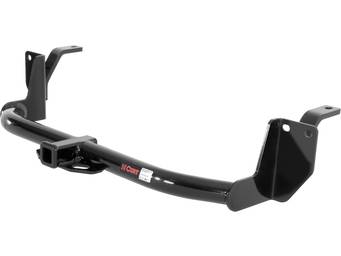Select Your Vehicle
Trailer Receiver Hitches
Only display items that ship the quickest
Receiver Hitches
Are you looking to bolster your truck, Jeep, or SUV’s functionality? At RealTruck, we offer several hitch receivers in varying classes, offering different strengths and weight limits to help you tow anything.
Receiver Hitch Classes
Hitch receivers come in several classes, ranging from 1–5, often depicted in Roman numerals as I–V. Each numerical class features a higher weight rating than the previous and is better suited for larger and more capable applications. These classes rank as follows:
Hitch Class | Receiver Size | Gross Trailer Weight |
Class I | 1-¼-inch | Up to 2,000 lbs. |
Class II | 1-¼-inch | Up to 3,500 lbs. |
Class III | 2-inch | Up to 8,000 lbs. |
Class IV | 2-inch | Up to 10,000 lbs. |
Class V | 2-½-inch | Up to 17,000 lbs. |
So what do all these numbers mean?
Receiver size relates to the inner diameter of the hitch receiver, which determines the size of the ball mount or accessory you can install; for instance, a 2-inch hitch receiver requires accessories with a 2-inch shank.
Gross trailer weight is the general weight rating of the hitch; however, that’s not the same as your vehicle’s towing capacity. Just because a hitch bolts to your vehicle and has a high weight rating, doesn’t mean your vehicle can now tow that weight. For instance, if a half-ton pickup has a maximum towing capacity of 6,000 pounds, but you install a 10,000-pound rated Class IV hitch, the pickup's towing capacity is still 6,000 pounds; you haven’t increased its towing capacity, you’ve simply installed a stronger hitch receiver.
In Layman’s terms, your vehicle can’t ever tow above its factory-defined capacity, even after installing a higher hitch class. For this reason, we always recommend installing a hitch that best suits your application. But what hitch class is that? Numbers aside, let’s look at the recommended uses of each hitch class.
Class I: These hitches are best suited for compact vehicles with low towing capacities. These hitches are ideal for gear carriers, like bike racks, and small, sub 2000-pound trailers.
Class II: These hitches are ideal for cars and minivans, towing up to 3,500 pounds. Class II hitches are commonly used to tow small boats, trailers, and gear mounts.
Class III: These hitches are ideal for small pickups, Jeeps, vans, and SUVs, towing up to 8,000 pounds. Class III hitches can handle medium-sized boats, small campers, etc.
Class IV: These hitches are often used on half-ton or heavy-duty pickups, featuring a respectable 10,000-pound weight limit. Class IV hitches can haul larger campers, boats, horse trailers, and sizable accessories.
Class V: These hitches are ideal for heavy-duty, one-ton, or larger pickups and commercial vehicles, featuring a 17,000-pound weight limit. Use a Class V hitch to tow car haulers, multi-car trailers, horse trailers, or practically anything else!
